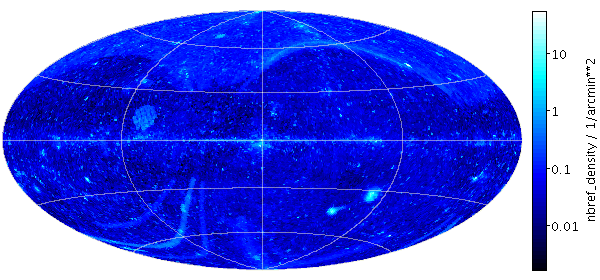
healpix
Plots a table representing HEALPix pixels on the sky. Each row represents a single HEALPix tile, and a value from that row is used to colour the corresponding region of the sky plot.
The way that data values are mapped to colours is usually controlled by options at the level of the plot itself, rather than by per-layer configuration.
Usage Overview:
layerN=healpix datalevelN=<int-value> datasysN=<value> degradeN=<int-value>
combineN=sum|sum-per-unit|count|...
perunitN=steradian|degree2|arcmin2|arcsec2|mas2|uas2
transparencyN=0..1 healpixN=<num-expr> valueN=<num-expr>
inN=<table> ifmtN=<in-format> istreamN=true|false
icmdN=<cmds>
All the parameters listed here
affect only the relevant layer,
identified by the suffix
N.
Example:

stilts plot2sky layer1=healpix in1=simbad-hpx8.fits healpix1=HPX8 value1=NBREF
datalevel1=8 degrade1=2 combine=sum-per-unit perunit=arcmin2
projection=aitoff datasys1=equatorial viewsys=galactic labelpos=none gridcolor=beige
auxfunc=log auxmap=cold auxflip=true auxclip=0,1
xpix=600 ypix=280
combineN = sum|sum-per-unit|count|... (Combiner)
degrade>0.
For density-like values
(count-per-unit,
sum-per-unit)
the scaling is additionally influenced by the
perunit
parameter.
The available options are:
sum: the sum of all the combined values per binsum-per-unit: the sum of all the combined values per unit of bin sizecount: the number of non-blank values per bin (weight is ignored)count-per-unit: the number of non-blank values per unit of bin size (weight is ignored)mean: the mean of the combined valuesmedian: the medianq1: first quartileq3: third quartilemin: the minimum of all the combined valuesmax: the maximum of all the combined valuesstdev: the sample standard deviation of the combined valuesstdev_pop: the population standard deviation of the combined valueshit: 1 if any values present, NaN otherwise (weight is ignored)[Default: mean]
datalevelN = <int-value> (Integer)
[Default: -1]
datasysN = <value> (SkySys)
[Default: equatorial]
degradeN = <int-value> (Integer)
degrade input tiles.
The way that values are combined within each painted tile
is controlled by the
combine value.
[Default: 0]
healpixN = <num-expr> (String)
The value is a numeric algebraic expression based on column names as described in Section 10.
icmdN = <cmds> (ProcessingStep[])
inN.
The value of this parameter is one or more of the filter
commands described in Section 6.1.
If more than one is given, they must be separated by
semicolon characters (";").
This parameter can be repeated multiple times on the same
command line to build up a list of processing steps.
The sequence of commands given in this way
defines the processing pipeline which is performed on the table.
Commands may alternatively be supplied in an external file,
by using the indirection character '@'.
Thus a value of "@filename"
causes the file filename to be read for a list
of filter commands to execute. The commands in the file
may be separated by newline characters and/or semicolons,
and lines which are blank or which start with a
'#' character are ignored.
A backslash character '\' at the end of a line
joins it with the following line.
ifmtN = <in-format> (String)
inN.
The known formats are listed in Section 5.1.1.
This flag can be used if you know what format your
table is in.
If it has the special value
(auto) (the default),
then an attempt will be
made to detect the format of the table automatically.
This cannot always be done correctly however, in which case
the program will exit with an error explaining which
formats were attempted.
This parameter is ignored for scheme-specified tables.
[Default: (auto)]
inN = <table> (StarTable)
-",
meaning standard input.
In this case the input format must be given explicitly
using the ifmtN
parameter.
Note that not all formats can be streamed in this way.:<scheme-name>:<scheme-args>.<" character at the start,
or a "|" character at the end
("<syscmd" or
"syscmd|").
This executes the given pipeline and reads from its
standard output.
This will probably only work on unix-like systems.istreamN = true|false (Boolean)
inN parameter
will be read as a stream.
It is necessary to give the
ifmtN parameter
in this case.
Depending on the required operations and processing mode,
this may cause the read to fail (sometimes it is necessary
to read the table more than once).
It is not normally necessary to set this flag;
in most cases the data will be streamed automatically
if that is the best thing to do.
However it can sometimes result in less resource usage when
processing large files in certain formats (such as VOTable).
This parameter is ignored for scheme-specified tables.
[Default: false]
perunitN = steradian|degree2|arcmin2|arcsec2|mas2|uas2 (SolidAngleUnit)
combine=count-per-unit or
sum-per-unit).
If the Combination mode is calculating values per unit area,
this configures the area scale in question.
For non-density-like combination modes
(e.g. combine=sum or
mean)
it has no effect.
The available options are:
steradian: (180/Pi)^2 deg^2degree2: square degreesarcmin2: square arcminute, (1/60)^2 deg^2arcsec2: square arcsecond, (1/3600)^2 deg^2mas2: square milliarcsecond, (.001/3600)^2 deg^2uas2: square microarcsecond, (1e-6/3600)^2 deg^2[Default: degree2]
transparencyN = 0..1 (Double)
[Default: 0]
valueN = <num-expr> (String)
The value is a numeric algebraic expression based on column names as described in Section 10.